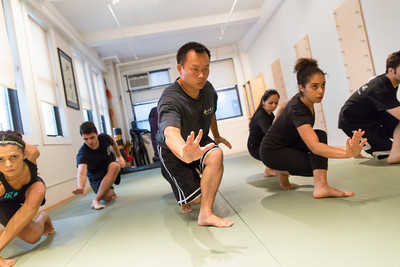Below is the second part of our interview with Xing Yi Quan marital arts practitioner Frank Kyle of the Xingyi Martial Arts Club.
Athletified: Can you describe what sparring looks like in Xing Yi Quan?
Frank Kyle: I was not trained initially to spar in Xing Yi Quan. My first art was a Shaolin-based style, and I was just thrown into the pool with a sink or swim attitude from the teacher. Do it often enough, and you figure it out. I much prefer a slow build up to sparring with my own students. For their safety and so they can actually learn better.
If you know nothing of fighting and have someone just come at you, you don’t know what to do and freeze up. You get your butt kicked. Do you learn anything? Not really, because you don’t even know where to start improving from. I have a weekly class I call push-hands. It is a class where I can safely teach my students skills that they can practice and work on while we gradually pressure test them with control. We do not want to hurt our training partners, and push-hands is an excellent training tool to start experimenting from.
I teach them to break falls and some basics of standing grappling. It is done without striking, and only wrestling techniques done slow and build up to full speed. After a student demonstrates he has control, we then move on to what we call water boxing. This is a slower pace of ebb and flow. Where you can strike or move into standing grappling. Your partner will match your speed, and the pace is slow enough to think and flow with the opponent, learning timing and distance. After some time at water boxing, it is time for actual sparring. This incorporates strikes, standing grappling, throws, sweeps, trips, or joint locks.
Athletified: Can you explain how breathing connects to movement in Xing Yi?
Frank Kyle: Every movement in Xing Yi, Bagua, and Tai Chi is either an opening or closing movement. The hips open up and close, the shoulders open and close. Those joints open and close like a door. When your body expands, it opens, so you are opening the joints. You’re usually pushing on something to breathe out when you expand out. When everything comes in, you breathe in. So when it closes, you breathe in so you can expand and breathe out. That’s the most that you need to know. As an athlete, nasal breathing is the way to go. The sinus cavity filters the air and moistens the air that goes to the lungs. I tell my students to breathe through the nose into the belly and connect it to the movement.

Athletified: What are the most challenging concepts to grasp for beginners?
Frank Kyle: I structure my class with new students in their first lesson to correct their structural alignment when they stand with gravity. If they leave and work on only that, their lives have improved immensely. Posture is so bad because of cellphones and sitting behind desks all day. So if I can correct their posture, I have helped them immensely, and they don’t even know how much I have helped their health.
Then after some structural fixes, the first true concept I teach is “Peng Jin.” It is an outward expansion of your intention, which causes the very fine small muscles to expand out in your body while holding proper alignment and being relaxed. It usually takes most of my adult students a couple of classes to understand while trying to push on me. I let my students feel the energetics, and that’s why you can’t learn this through a computer.
“You Can’t Learn Xing Yi Through a Computer” – Frank Kyle
You have to have someone that can demonstrate and let you feel to get it right and practice it. I can’t correct your posture through a computer. I let my students push on me, and I show them and let them feel when I have Peng Jin. They feel my muscles, biceps, and forearms that they are not flexing. I show them they are pushing against my structure, and Peng Jin holds the shape of my frame. They are loading a spring, and I am grounding their pushing force.
They might as well be pushing a wall. I then have them feel the resistance pushing against them as the spring pushes back because it is loaded. Then when they stop pushing the spring (me), I expand back to the original position, and they rebound off. To some, it seems magical, but it is purely physics and not magical at all. That is the first of several concepts that are hard to explain to a new student and impossible to understand without feeling it. But it is a fundamental principle that is useful in all martial arts.
Athletified: What would you tell the average person who may be thinking about learning Xing Yi Quan aside from the self-defense aspect?
Frank Kyle: Kung Fu actually means supreme skill through hard work. Improving your skills is hard work. That’s what Kung Fu is. By practicing Xing Yi, you get body conditioning, calisthenics, and some strengthening exercises. You get your posture corrected as well as mediation. It is about bettering yourself daily. Many people think that bettering yourself happens at one time and you’re successful, and that’s not how it actually works. Sometimes you don’t see the progress until you get down the road, but you look back and say, “wow, I’m already this far!” That’s what Kung Fu can give you. It’s a way to exercise and learn skills that could potentially save your life.
Athletified: Have you had any student come to you with a medical issue that Xing Yi Quan has helped improve?
Frank Kyle: I have a student who is an insulin-dependent diabetic who has lost half of his foot. When he came to me, he was walking hunched forward, looking at the ground. He wouldn’t glance up and made a big deal about having half of his foot taken and that he needs a brace. I started teaching him Tai Chi and Xing Yi using the stepping exercises and postural correction. The student started walking upright, and mentioned that it seemed like he grew two inches taller. He no longer feels like he needs his brace to walk around the house to do little things. He can be completely mobile without a brace or prosthetic foot for his shoe. The student now takes classes without the prosthetic and no longer looks at it as a complete weakness but something he had to workaround.

Athletified: What kind of events does Xingyi Martial Arts Club offer for those interested?
Frank Kyle: Xing Yi Martial Arts Club hosts skill-based seminars and events, usually the first week in June and November, that we post on Facebook with quality world-class instructors. On June 5-6, we are hosting a ground proofing seminar. One of the main people we bring out is Tim Cartmell. He is a 5th-degree black belt in Brazilian jiu-jitsu. Tim forgoes all of the sports techniques of the choke, holds, and teaches a person how to get up off the ground safely when someone wants to put you there or keep you there. He teaches you three high percentage escapes from the ground. Tim teaches you how to do a tactical get-up and how to break fall, so if you’re thrown to the ground, you know how to fall safely.
This is an excellent supplement for styles that lack groundwork like Taekwondo, Wing Chun, Kung Fu styles, some Korean styles, and some karate. This is a good seminar from someone who has 25-30 years of Brazilian jiu-jitsu and is a world champion multiple times to show you what works. This works. I’ve tested it numerous times. They use it in MMA.
We typically have a seminar at the start of November. Every year we’ve had it, we’ve focused on Bagua. This is where someone can come and learn the core principles of Bagua of the single palm and double palm change. You get 10 hours and learn the basics of the system. We teach some applications and partner work. Throughout the years, we’ve been adding more and more instruction.
These are open to anyone. If you have no skills in martial arts or a martial arts background. These seminars supplement what you already know. So, for example, if you are a ground person, Bagua is great for stand up.
Athletified: How can someone contact you or Xingyi Martial Arts Club?
Anyone interested can reach me through our Facebook account, Xingyi Martial Arts Club, or email us at xingyischool@rocketmail.com.





